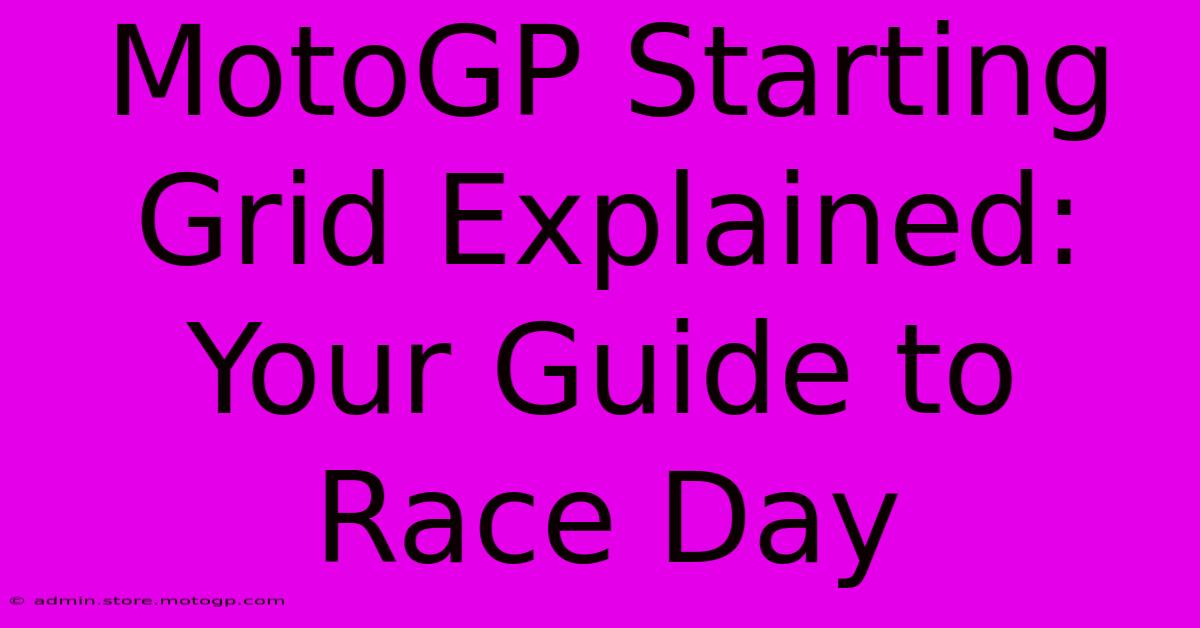MotoGP Starting Grid Explained: Your Guide To Race Day

Table of Contents
MotoGP Starting Grid Explained: Your Guide to Race Day
The roar of the engines, the smell of burning rubber, the breathtaking speeds… MotoGP is a spectacle unlike any other. But before the lights go out and the riders thunder down the track, there's a crucial element that often gets overlooked: the starting grid. Understanding how the MotoGP starting grid is formed is key to appreciating the nuances of the race and predicting potential outcomes. This guide will break down everything you need to know.
How the MotoGP Starting Grid is Determined
The starting grid for a MotoGP race isn't random; it's meticulously determined through a series of qualifying sessions held throughout the race weekend. The process aims to place the fastest riders at the front, maximizing the potential for exciting racing and rewarding skill and performance.
Qualifying 1 (Q1): The Fight for Q2
Not all riders start equally. Q1 is where riders who didn't finish within a certain time during the free practice sessions compete. The top two riders from Q1 then advance to Qualifying 2 (Q2). This initial qualifying session sets the stage for the main event, providing a crucial chance for riders further down the standings to improve their grid position. It's a high-stakes battle for those aiming for a better starting position.
Qualifying 2 (Q2): The Showdown for Pole Position
Q2 brings together the top 10 riders from the combined free practice times and the two qualifiers from Q1. This is where the real fight for pole position begins. Riders have a limited time to set their fastest lap, pushing their machines and themselves to the absolute limit. The rider with the fastest lap time earns the coveted pole position, securing the prime starting spot on the grid. The remaining riders in Q2 are then slotted into positions behind the pole sitter based on their lap times.
The Importance of Qualifying Performance
The starting grid significantly impacts race outcomes. A good starting position offers several advantages:
- Clean Launch: A clear run off the line minimizes the risk of collisions and allows for better acceleration.
- Track Position: Being at the front allows riders to control the pace and choose their lines, maximizing their chances of success.
- Strategic Advantage: Starting near the front allows for better race management and strategic opportunities to overtake or defend positions.
Understanding the Grid Formation
The MotoGP starting grid follows a specific layout. The grid is typically 3 rows wide and 4-5 rows long (depending on the number of riders competing). Pole position is on the far left of the front row. This means the rider in pole position has the inside line for the first corner, a substantial advantage.
Factors Affecting Starting Grid Position
Beyond pure speed, several factors contribute to a rider's starting grid position:
- Bike Setup: A well-tuned motorcycle plays a vital role in achieving fast lap times. The slightest adjustments can make a huge difference.
- Tire Choice: Selecting the right tires for the track conditions is critical for achieving optimal grip and performance.
- Track Conditions: Weather, temperature, and even track surface changes can significantly affect lap times.
- Rider Skill and Experience: A rider's skill and experience in handling the bike and navigating the track are key factors in setting quick lap times.
Beyond the Grid: Race Day Dynamics
While the starting grid is a crucial factor, it's not the only determinant of race results. Overtaking, strategy, and unexpected events can all drastically alter the race's outcome. A rider starting further back can still win the race with a combination of skill, strategic maneuvering, and a bit of luck.
Understanding the MotoGP starting grid process allows you to better appreciate the intricate strategies and intense competition that define this exhilarating sport. So, next time you watch a MotoGP race, pay close attention to qualifying—it’s where the foundations for an unforgettable race day are laid.

Thank you for visiting our website wich cover about MotoGP Starting Grid Explained: Your Guide To Race Day. We hope the information provided has been useful to you. Feel free to contact us if you have any questions or need further assistance. See you next time and dont miss to bookmark.
Featured Posts
-
Cota The Riders Playground Awaits
Feb 20, 2025
-
Moto Gp Rider Down Todays Race Takes A Turn
Feb 20, 2025
-
Explore The World Through Bike Racing On Tv
Feb 20, 2025
-
Cota Qualifying Secrets To A Winning Qualifying Run
Feb 20, 2025
-
How Moto Gp Speed Creates Unforgettable Races
Feb 20, 2025
